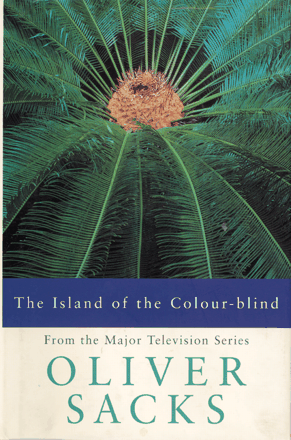Island Lore
- Christie Carrico, PhD
The Island of the Colour-Blind. Oliver Sacks. London: Picdor; 1996. 345 pages. £16.99. ISBN: 0330350811
Those of you who have read Uncle Tungsten (or even the book review thereof1) will remember that, as a child, Oliver Sacks was captivated by chemistry, even though he grew up to become a neurologist. In The Island of the Colour-Blind, Oliver Sacks combines his professional interest in neurological disorders with still other of his fascinations—islands and botany. The book is divided into two parts, the chapters of which carry the names of the islands described. Book One is about Pingelap and Pohnpei and their indigenous color-blind populations. Book Two is about Guam and Rota and their populations, which include individuals that manifest a parkinsonian disease reminiscent of amyotrophic lateral sclerosis (ALS).
In the early 1990s, Sacks had learned of an isolated population, on the atoll of Pingelap (in the Caroline Islands), that displayed congenital achromatopsia, or complete color-blindness. A few years later, he made a pilgrimage to Pingelap to study this population, accompanied by a Norwegian physiologist, himself an acromatope (i.e., one who is completely colorblind). Ten percent of the population of Pingelap are achromatopes. Achromatopsia, referred to as “maskun” (literally, “not-see”) by the Pingelapese, is characterized not only by the inability to see colors, but also by exquisite hypersensitivity to light, nystagmus (i.e., involuntary oscillation of the eyeballs), and poor visual acuity. Achromatopes, however, can discern variations in low-level light intensity that are imperceptible to a color-seeing person. Sacks and his team also visited the nearby island of Pohnpei to examine the achromatopic population there. Most of the two chapters devoted to Pingelap and Pohnpei, however, describe the islands, their history, their vegetation, and their culture. These descriptions are truly vivid; Sacks convincingly takes his reader on an outrigger, into a rainforest, and then out to swim about the reef. Sacks is also addicted to tangential information and frequently intersperses his narrative with such. For example, while discussing a native dinner including Spam and a hallucinogenic beverage made from hibiscus, Sacks takes time out to expound Paul Theroux’s theory that natives across the South Pacific, predominantly descended from cannibals, ubiquitously enjoy Spam because it closely approximates the “porky taste of human flesh.” Hmmmm.
Book Two covers a second trip to Micronesia and includes chapters on Guam and Rota. The single chapter on Guam makes up virtually half the book and describes Sacks’s interaction with a local physician, John Steele, and the native Chamorro population of the island, most of whom are afflicted with a disease, or diseases, known as “lytico-bodig.” “Lytico” refers to a progressive paralysis that resembles ALS; “bodig” resembles parkinsonism, sometimes with accompanying dementia. Many of the Chamorros display both aspects, although there is recent evidence to indicate that these are two separate diseases. Both conditions are reminiscent of the symptoms seen in the description of postencephalitic paralysis offered in Sacks’s book Awakenings and thus explain his interest in the Chamorro population. As in the case of the postencephalitic patients in Awakenings, affected Chamorros manifest neurofibrillatory tangles at the cellular level, and at the motor level, can similarly be roused out of their catatonia through engagement in ball throwing or stair climbing. Interestingly, lytico-bodig is almost ubiquitous in the Chamorro population born before 1940, but totally absent in those born after 1952. The disease may come on slowly, or explosively, overnight. One theory is that the disease is caused by a slow neurotoxin found in cycads, from which the Chamorros make a flour and on which they had to subsist almost entirely during the Second World War. Other theories include mineral deficiency/toxicity, genetics, prions, and various combinations of these. There is conflicting evidence in regard to all theories, and with the afflicted population dying out, there is a strong possibility that we will never know what causes the disease.
Reading Oliver Sacks is like going to a sumptuous buffet. You think you are heading straight for the prime rib and turkey and all of a sudden, an unexpected little delicacy (not Spam) is put on your plate that proves irresistible. Just as you are reading about the lytico-bodig and its causative theories, he sidesteps into a fern forest and describes the rare and beautiful specimens he sees there. Indeed, this book is accompanied by ninety-four endnotes, comprising eighty-five pages, that offer as much information and reading pleasure as does the main text; my dilemma was whether to read them intermittently, as they were referenced, or to wait until the end of the chapter. As in the earlier chapters, the chapter on Guam is as much about the history, geography, botany and culture of the island as it is about the neurological conditions found there.
The final chapter of the book, on Rota, is devoted entirely to plants, namely, the cycads, which may or may not be the cause of lyticobodig in the Chamorro population. Sacks is clearly in love with these plants, richly describing their habitat and their rugged botanical existence, dating from prehistoric times. Cycads can resist hurricane-force winds, and their cones can weigh more than 100 pounds, with scale patterns that follow a Fibonacci series. Cycad seeds have a buoyant layer within them that allows them to float on the water, perhaps accounting for their wide dissemination across the Pacific.
Sacks is an immensely readable writer, and his passages are frequently stirring, even poetic. One such phrase comes at the end of the chapter on Guam, in which he describes the lifetime of a genetic disease in an isolated population, and notes that “…then it vanishes, as do its memories and traces, lost in the ongoing stream of time.” I highly recommend this book, not only for its readability, but also for its educational value.
Oliver Sacks is a Professor of Neurology at the Albert Einstein College of Medicine. He is the author of numerous books addressing his widely varied scientific interests. He also raises cycads.
- © American Society for Pharmacology and Experimental Theraputics 2004






